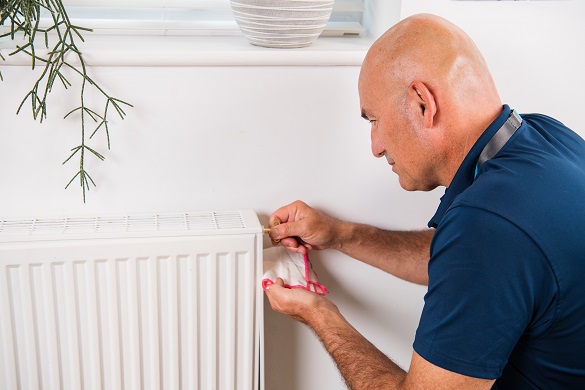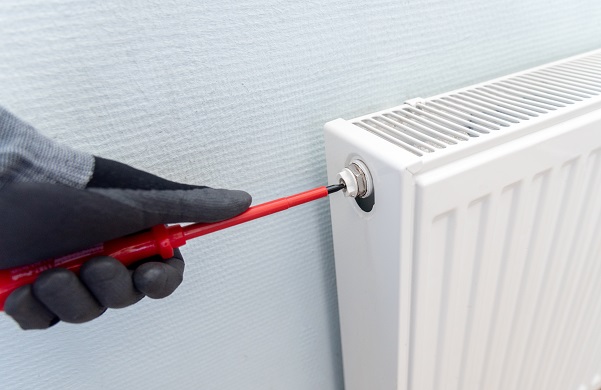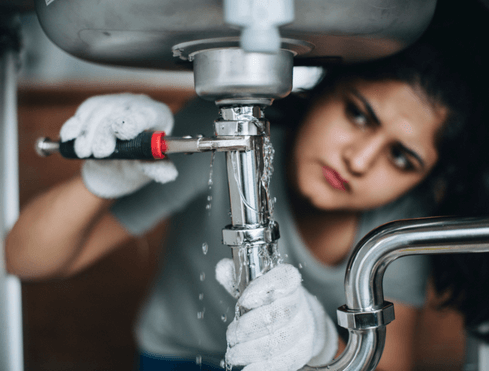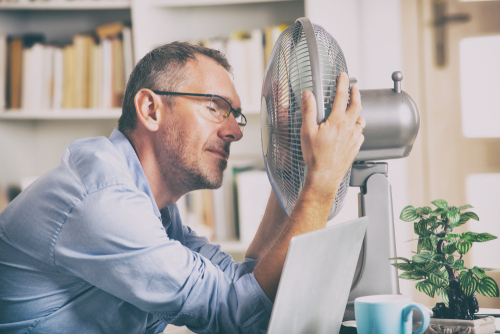If you want to use less energy – and possibly lower your bills – it’s worth looking after your radiators. Over time, water can drip out of leaky pipes or valves. This leads to air pockets in your radiators. And because air doesn’t heat up as well as water, the radiators won’t get as warm. This also makes your boiler work harder, as it’s trying to heat your home with less water. Bleeding a radiator is the way to fix this, by letting the air out. So let’s look at how to bleed a radiator.
How to check if your radiators need bleeding

Is the heating on, but your rooms aren’t as warm as they should be? Check for these signs that your radiators need bleeding:
- The boiler pressure is too high (it should be 1 to 1.5 bar or 15 to 20 psi)
- The radiators aren’t heating up properly
- The radiators are colder at the top but warm at the bottom
You might also notice that the radiators take a long time to heat up, or they make gurgling noises.
Watch our video on how to bleed a radiator
Step-by-step guide to bleeding your radiators
First, follow the steps above to see which radiators need bleeding. Then figure out which radiator is farthest from the boiler, as that should be bled first. And if your house has two or more stories, start with the radiators that need bleeding downstairs before doing any upstairs. In this way, the water will push any trapped air up through the pipes, before you bleed the upstairs radiators. This helps you remove as much air as possible.
1. Find the tools you’ll need
You only need a couple of things to bleed a radiator:
- An old cloth or jug to catch water
- A radiator key or flathead screwdriver
You can get a radiator key from any hardware or DIY shop – they cost about £2. Take a photo of your radiator valve with you, so you can get the right key.
2. Let the radiators cool down
Before you start, turn off the heating and give the radiators time to cool down. Otherwise you could get very hot water on your hands.
3. Insert the radiator key and open the valve

Radiators have a bleed valve on one end, near the top. The part of the valve that you turn is a small metal square. It’s often inside a circle or hexagon of metal or plastic, depending on the radiator design. Insert the radiator key or flathead screwdriver into the valve. Turn it anti-clockwise until air starts coming out — you should hear a hissing sound.
4. Close the valve again
When water starts coming out of the valve, turn the key clockwise to close it again. Repeat steps three and four with all the radiators that need bleeding.
5. Turn the heating on and check the boiler pressure

Get your heating back up to temperature again and look at your boiler’s pressure gauge. It should be between 1 and 1.5 bar or 15 to 20 psi. To be sure, always check the exact details of your model in the manual. If the pressure is lower than 1 bar, you can increase it with the filling loop. For instructions on how to do this, see our boiler troubleshooting guide.
6. Test your radiators
When the heating’s back on, see how the radiators have changed. Do they heat up faster? Are they warm all the way to the top? Have they stopped making gurgling noises? If so, you’ve probably solved the problem.
How to bleed a radiator without a key

Radiator keys are handy, but you can bleed a radiator without one. You just need a flathead (slotted) screwdriver. Insert it into the slot in the radiator valve and turn it anti-clockwise to open. You should hear a hiss as the air escapes. When water starts to come out, turn the screwdriver clockwise to close.
When to contact a heating expert
Tried these steps, but your radiators still aren’t getting warm? There might be a problem with your boiler, or an unidentified leak in your heating system. First take a look at our advice on what to do if your boiler’s leaking. Then it might be time to call an engineer who’s qualified in boiler repairs
Our blog is loaded with more related articles

Plumbing and heating tips
Heating not coming on? There could be a simple fix...
It’s that time of year again, one of the busiest for heating engineers, when people start to turn their heating on after...
Read more

Plumbing and heating tips
Easy plumbing maintenance tips
Did you know that the earliest copper piping dates from an Egyptian pyramid built 4,500 years ago? Since plumbing has been arou...
Read more

Boiler help and advice
How to use your boiler in warmer weather
Should you turn off your boiler completely when it’s warm out? Check out our central heating tips and boiler care over th...
Read more
